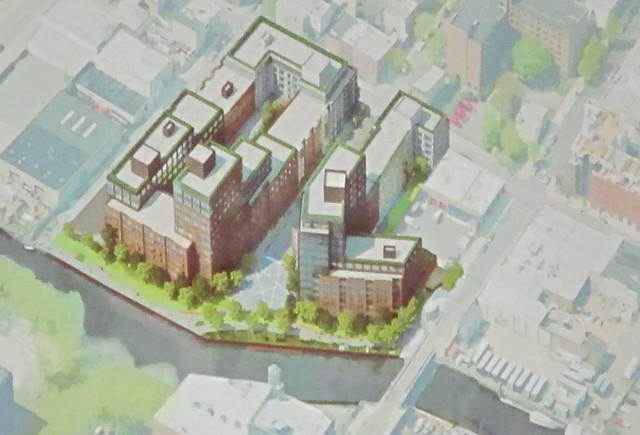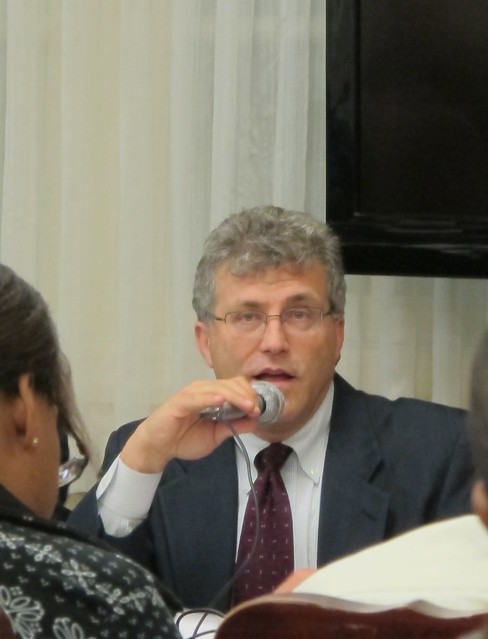CB6 Chairperson Daniel Kumer
At the meeting, the full board had rejected the recommendations of its own Landmark/Land Use Committee, which had passed a motion requesting that New York City Planning Commission table the Lightstone project until a supplemental Environmental Impact Study (EIS) is performed.
Instead, the Board put forth its own motion and voted to conditionally approving Lightstone's application for "minor modifications" to a previously passed land use actions at 363-365 Bond Street.
Below is the letter sent today by CB6 Chairperson Daniel Kumer to Amanda Burden, Chairsperson of NYC's Planning Commission. What is interesting is that Kumer speaks of the discomfort felt by the board with the 'minor modification' process, which did not allow for a traditional land use review and did not give the public, the board nor local electeds a real voice.
He also acknowledges that the community had expressed deep concern and that the Board would have preferred to look at the project within a broader Gowanus area framework.
It's an interesting read. Let me know what you think in the comment section.
Dear Chairperson Burden,
I am writing to advise you that at its October 10, 2012 general meeting Brooklyn Community Board 6 resolved by a vote of 27 in favor, 4 against, with 6 abstentions, to conditionally recommend approval of the proposed minor modifications contained in the applications cited above submitted by The Lightstone Group (TLG) for properties at 363-365 Bond Street in our district.
These applications will respectively seek (1) a 3-year renewal of the previously approved special permit for this property, and (2) approval of (a) some minor variations in building heights without permitting anything taller than what was previously approved, (b) elimination of two previously granted waivers that had been approved for height, setback and inner court recesses, (c) an increase in dwelling units from 447 to 700, (d) relocation of curb-cuts and entrances to accessory parking garages and permit an increase in off-street accessory parking spaces from 268 to 316, (e) expansion of the publicly accessible open space along the Gowanus Canal frontage by 10 to 12 feet with minor revisions to the design, (f) increasing the commercial floor area to 2,600 sf, community facility floor area to 2,250 sf and the total project floor area from 523,309 sf to 526,143 sf, and (g) adjustment of the lot area to conform to an updated survey.
Before commenting on the substance of these applications, we believe it is necessary to register our discomfort with the process under which these applications have come before the Community Board. The Department of City Planning has determined that this set of modifications proposed by TLG should be deemed “minor” and therefore not subject to the traditional uniform land use review procedures to which we are accustomed for development projects of this nature, which require a public review process that would include the Borough President and the City Council. As a result of that determination, it is our understanding that the referral of these applications is at best a courtesy extended by the department to the Community Board. Having never participated in a “minor modification” review before, we have from the outset been concerned about the potentially arbitrary procedure to which this application has been subjected, in which the role of the Community Board is entirely undefined by law, statute or regulation. In essence, the department’s referral placed our Community Board in a position of making up our own process as we went along – or even, at our election, possibly undertaking no process at all.
Even though we had no defined reviewing role, we take our responsibility as a representative body very seriously and thought that it would have been a great disservice to our community not to provide a venue for the public to learn about, review and comment on the substance of these applications. To that end, our Landmarks/Land Use Committee hosted an Informational Meeting on TLG’s proposal at their August 23, 2012 meeting, followed by a Public Hearing and formal review and deliberation by our committee at their September 27, 2012 meeting. Both meetings were extremely well-attended by members of our community indicative of the enormous interest our community has in matters pertaining to the future of the Gowanus Canal and its surroundings. As you know, a great deal has changed in the Gowanus Canal area since the commission previously approved a special permit for this property on a prior application, most notably the Environmental Protection Agency’s (EPA) inclusion of the Canal on their National Priorities List, or, more commonly, the Superfund designation. At both meetings, many community members expressed deep concern about allowing a project of this size – with a significantly increased number of dwelling units and residents – to go forward at this location during the pendency of the Superfund cleanup process, among other strong objections. Many other community members spoke equally strongly in favor of the project.
We understood that TLG could have simply chosen to follow the path laid out by the approvals that were granted to the previous applicant. However, to TLG’s credit, it was noted by many of our committee and board members that a number of TLG’s proposed modifications constitute a material improvement over what was previously approved. Specifically, we saw a net increase in the number of affordable housing units from 130 to 140 units, which are guaranteed rather than contingent on receipt of public subsidies. Of equal if not greater importance, the individual affordable housing units would be indistinguishable from and integrated with the market rate units, in stark contrast to the project that was previously approved, which would have involved segregated and inferior affordable units. We also took note of the wider waterfront access space that will be created by increasing the setback of the building line from the canal. And we especially noted that while the EPA does not take positions on the appropriateness of any given redevelopment proposals, it issued written confirmation that in its view this proposal is not inconsistent with their goals for the Gowanus Canal under the Superfund program, and will not interfere with carrying out the Superfund cleanup process.
Turning to the conditions of our approval, we were, by contrast, especially displeased at TLG’s failure to directly address the points we have conveniently outlined for large-scale developers who appear before us as codified in our Responsible Development Policy (copy enclosed). While we do not expect every applicant to adhere to every standard in our policy, we do expect that a good faith effort should be made to affirmatively respond and demonstrate that they have at least considered them. Our policy was developed, circulated and is publicly available on our website as a way of streamlining our review process since we found that most large-scale projects evoked common interest in subjects such as the experience and track record of the developer, good neighbor policies, hiring and training, wages and benefit standards, local business opportunities, affirmative action opportunities, affordable housing, contextual development, etc. We are still hopeful that TLG will see their way clear to comment on and, to the greatest extent possible, abide by the standards outlined in our policy and although we otherwise express our approval we ask that you take no action on their application unless and until they do so.
The second condition of our approval relates to the fact that we currently lack a context for this application absent a comprehensive rezoning framework for the Gowanus Canal corridor, as was begun by your department years ago but then abruptly and indefinitely suspended shortly after the EPA’s Superfund designation for the area. The net result of the department’s action retroactively turns the previous approvals for this site – which we viewed as a leading land use action with an expectation of a larger, departmental action to follow – into a case of spot rezoning. Without a broader framework, and an area-wide Environmental Impact Statement, land use analysis, etc., we are at an extreme disadvantage in considering the context for this project and, most especially, any other projects that might come across our desks in the near future. Indeed, the valid frustration expressed by numerous board members in this regard produced a motion at our general meeting earlier this week – ultimately defeated by the rarest and narrowest of margins, namely, the tie-breaking vote of the undersigned – which called for returning this application to your department with no comment at all and a refusal to consider any further individual applications in the Gowanus area unless and until that area-wide rezoning is resumed and completed.
In the end, the board voted to express approval of this application, but we have firmly conditioned our approval on the department’s commitment to reactivate the Gowanus rezoning effort. We are prepared, and eager, to work constructively with your department to that end.In closing, I hope you can appreciate that our Community Board has devoted an enormous amount of time and very careful consideration into this matter, notwithstanding our entirely undefined and essentially optional role, and that our board members as well as members of our wider community have extremely strong views on this matter and the larger context in which it arises. Since our Gowanus Canal corridor is in such a critical stage of development and planning, and commands the attention of every level of government and a wide spectrum of interested parties, it would be especially reassuring for us to hear your feedback directly about our concerns and conditions as part and parcel of our recommendation of approval of these applications.
I look forward to hearing from you and thank you for the opportunity to comment.
Sincerely,
Daniel M. Kummer Chairperson
cc: Hon. Marty Markowitz Hon. Brad Lander Hon. Joan Millman Hon. Daniel Squadron Hon. Nydia Velázquez Purnima Kapur, Director, DCP/Brooklyn Jay A. Segal, Greenberg Traurig LLP (for the Applicant)
A copy of the resolution is available by clicking here













